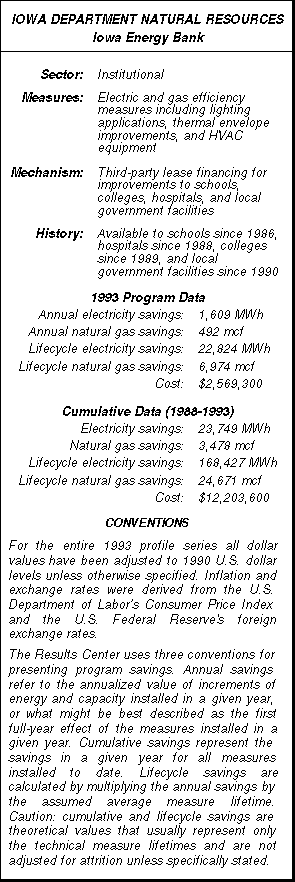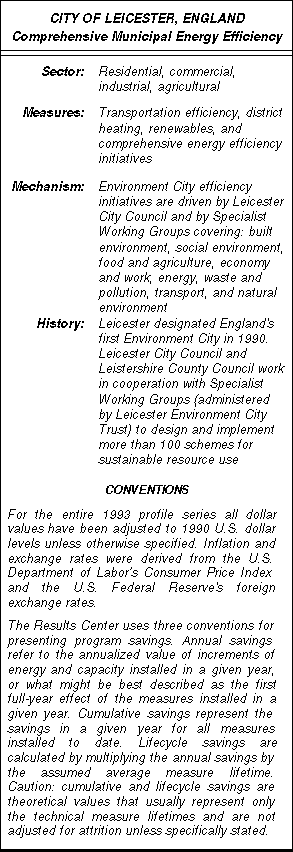EXECUTIVE SUMMARY
 The State of Iowa has proven to be an incubator for good ideas and the Iowa Energy Bank is yet another home-grown concept that deserves recognition and that will likely result in replication. The Energy Bank has been spurred on by several factors not the least of which has been the state’s 97% dependence on out-of-state energy supplies. Iowa is not only energy poor, but annual energy purchases have drained its economy to the tune of over $4 billion per year.
The State of Iowa has proven to be an incubator for good ideas and the Iowa Energy Bank is yet another home-grown concept that deserves recognition and that will likely result in replication. The Energy Bank has been spurred on by several factors not the least of which has been the state’s 97% dependence on out-of-state energy supplies. Iowa is not only energy poor, but annual energy purchases have drained its economy to the tune of over $4 billion per year.
In 1985 the Iowa legislature mandated its Department of Natural Resources to design and implement major energy efficiency initiatives for traditionally difficult market segments: public and non-profit facilities. The resulting Iowa Building Energy Management Program targets state and local government facilities, public school districts and area education agencies, private universities, hospitals, and other non-profit groups. The goal of the program is to install all cost-effective efficiency improvements in these facilities with an aggregate payback period of six years or less by 1998.
The Iowa Energy Bank is a subset of the Building Energy Management Program and was established to facilitate and finance energy improvements in Iowa’s 418 school districts, 128 hospitals, 34 private colleges and 15 community colleges, and 967 local governments. (State facilities are addressed under a parallel program called the State of Iowa Facilities Improvement Corporation.) The Department of Natural Resources determined that a combination of audits and engineering analysis followed by lease financing was the most attractive mechanism for the retrofits, allowing public institutions to avoid issuing bonds or calling public referendums to secure the necessary capital. This form of financing also allows the costs of the payments to be less than or equal to the monthly savings from the improvements, providing a win-win situation in this debt-averse state. Participants can also secure financing from alternative sources and the program has recently been enhanced to take advantage of capital loan notes.
Cumulative enrollment in the Energy Bank to date has been very impressive. Already the program has reached 390 participants or 22% of the eligible customers with 265 school districts providing the largest fraction of the savings. Twenty-one hospitals have also undergone retrofits. Of the total participants, 212 have financed improvements through the Energy Bank engaging $8,927,400 worth of retrofit improvements which have resulted in cumulative savings of nearly 23 GWh and over 105 GWh equivalent of natural gas.
[CLICK HERE TO DOWNLOAD THE ENTIRE 20 PAGE PROFILE IN PDF FILE FORMAT]
This profile was produced by

 Puget Sound Power and Light’s Commercial and Industrial Electricity Conservation Service (CIECS) has been available since late 1978 and as such was one of the first DSM programs of its kind to be offered to the commercial sector. Puget’s philosophy behind the service is based on the utility’s strong commitment to the installation of cost-effective conservation measures in commercial and industrial facilities, in new and existing applications in its service territory to control load growth and to provide valuable customer services.
Puget Sound Power and Light’s Commercial and Industrial Electricity Conservation Service (CIECS) has been available since late 1978 and as such was one of the first DSM programs of its kind to be offered to the commercial sector. Puget’s philosophy behind the service is based on the utility’s strong commitment to the installation of cost-effective conservation measures in commercial and industrial facilities, in new and existing applications in its service territory to control load growth and to provide valuable customer services. Leicester is a post-industrial city about an hour and a half north of London by train which has the wonderful distinction of being Britain’s first Environment City. This university town with a diverse ethnic mix has initiated perhaps the most comprehensive set of environmental programs ever witnessed by The Results Center. While its completed energy efficiency initiatives are primarily limited to its own municipal buildings, the strength of this profile is in Leicester’s broad environmental platform and wealth of programs.
Leicester is a post-industrial city about an hour and a half north of London by train which has the wonderful distinction of being Britain’s first Environment City. This university town with a diverse ethnic mix has initiated perhaps the most comprehensive set of environmental programs ever witnessed by The Results Center. While its completed energy efficiency initiatives are primarily limited to its own municipal buildings, the strength of this profile is in Leicester’s broad environmental platform and wealth of programs. Hannover is a capital for energy efficiency in Europe and has worked on a comprehensive approach to energy management that includes supply-side efficiency, district heating, transportation efficiency, water efficiency, promotion of renewable energy, and more conventional energy efficiency. Its efficiency initiatives are a subset of the City’s far broader drive toward sustainability and environmental stewardship and have been spurred on by concerns about foreign oil dependence and the Chernobyl nuclear accident, concerns that translated into the City’s progressive Energy Plan and Climate Protection Program.
Hannover is a capital for energy efficiency in Europe and has worked on a comprehensive approach to energy management that includes supply-side efficiency, district heating, transportation efficiency, water efficiency, promotion of renewable energy, and more conventional energy efficiency. Its efficiency initiatives are a subset of the City’s far broader drive toward sustainability and environmental stewardship and have been spurred on by concerns about foreign oil dependence and the Chernobyl nuclear accident, concerns that translated into the City’s progressive Energy Plan and Climate Protection Program.